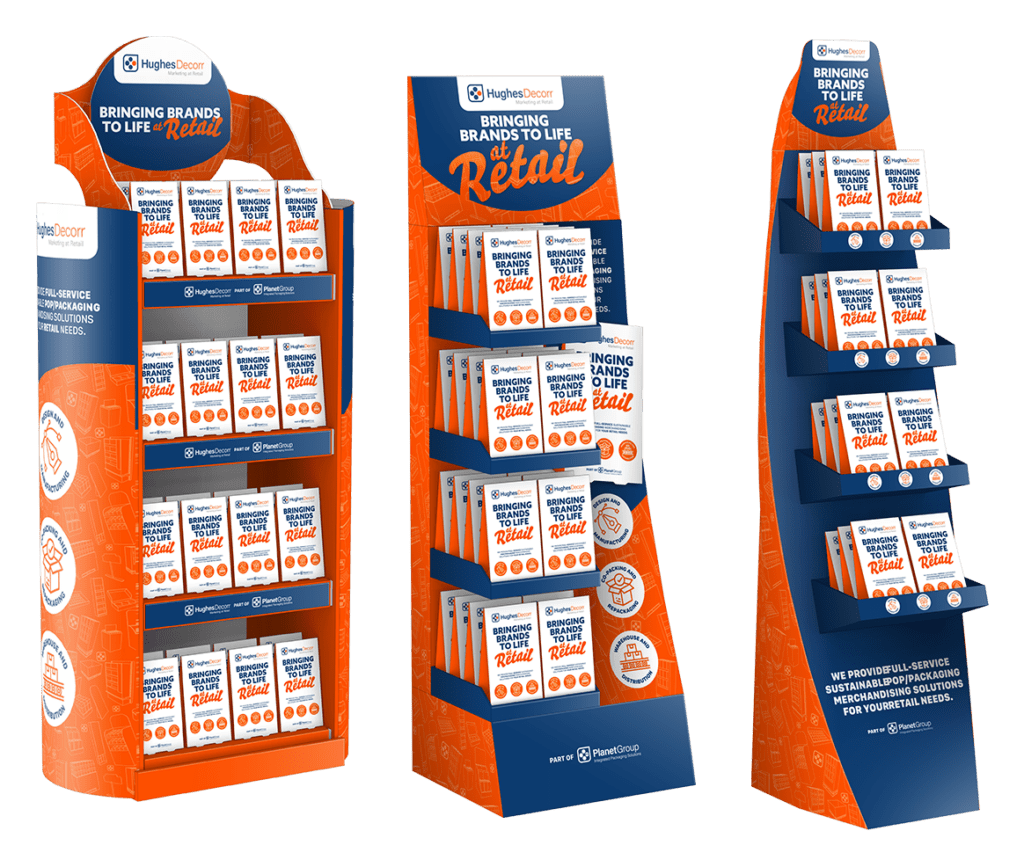In retail, the design of a store plays a pivotal role in attracting customers and driving sales. To this end, 3D rendering is an essential tool when it comes to creating engaging Point of Sale (POS) displays. This technology’s ability to produce accurate and lifelike marketing fixtures offers huge advantages.
Let’s dive into what exactly 3D rendering is, how POS displays work, and what the benefits of 3D rendering POS displays are for retail businesses.

Understanding 3D Rendering and POS Displays
First, let’s establish a foundational understanding of 3D rendering and POS displays.
What is 3D Rendering?
3D rendering is a digital process, one that is heavily used by interior designers and architects, that converts three-dimensional models into 2D images or animations. This technique uses computer graphics to create lifelike or photorealistic representations of objects, environments, and scenes.
In 3D rendering, detailed digital models are created using 3D modeling software, and then textures, colours, and lighting effects are applied to achieve the desired appearance. By offering an accurate visual representation during the design phase, 3D rendering facilitates decision-making.
What Can POS Displays Accomplish?
Point of Sale (POS) displays are specialized marketing units or fixtures designed to promote products and encourage purchases at the point where the sale takes place, typically near or at the checkout area in retail stores. These displays are strategically placed to attract customers’ attention to products, which might include new items, promotions, or seasonal goods.
POS displays can vary widely in design, size, and complexity, ranging from simple shelf signage and countertop stands to elaborate floor displays and interactive units. The effectiveness of POS displays comes from their ability to enhance product visibility, engage customers, and drive sales. By making products more appealing and accessible when consumers are ready to make purchase decisions, POS displays boost the chances of impulse buys.
3D Rendering for Retail Design – Efficiency and Flexibility

Now, let’s explore the various benefits 3D rendering brings to POS and retail store design.
Design Flexibility
3D rendering provides an exceptional level of design flexibility for Point of Sale (POS) displays. The ability to tweak the shape, colours, lighting, and positioning in a virtual environment ensures that the final design maximizes product visibility.
For example, a designer can experiment with different types of POS displays, such as countertop units for highlighting impulse purchases, free-standing display units for special promotions, or end-cap displays to draw attention to new products.
Enhanced Visualization
Photorealistic renderings elevate the visualization process. They offer a vivid and detailed preview of Point of Sale (POS) displays within a virtual retail environment. This advanced visualization helps stakeholders understand how displays will appear and interact within their retail space, ensuring the design aligns with brand aesthetics and customer experience goals. The ability to preview and adjust the design in real-time leads to a higher level of precision and satisfaction with the final outcome.
Cost and Time Efficiency
Using 3D rendering to design POS displays significantly reduces both time and costs. Specifically, it eliminates the need for traditional prototyping and extensive revisions. By identifying design challenges and opportunities during the virtual stage, businesses avoid the expenses of creating physical mock-ups. As a result, they minimize the need for multiple iterations. This efficiency accelerates the design process and allows businesses to allocate more resources toward innovation and quality enhancements.
Sustainability
Similarly, 3D rendering contributes to sustainability in retail design by minimizing the need for physical prototypes, thus reducing waste and material consumption. This approach aligns with eco-friendly practices, as it allows for extensive testing and refinement of designs virtually, without the environmental impact associated with traditional prototyping methods.
Marketing Materials for Pre-Sales Campaigns
High-quality 3D renders of POS displays serve as powerful marketing tools. They enable companies to generate buzz and anticipation before a product launch. These renders can be featured on various digital platforms, such as websites, social media, and email campaigns. Additionally, they provide customers with an exciting preview of upcoming displays and promotions. As a result, this pre-sales engagement effectively builds customer interest in a product or promotion.

Increased Engagement and Sales
Visually appealing, 3D rendered POS displays significantly impact customer engagement and sales in retail businesses. By simulating real-life settings and showcasing products in their best light, these displays enhance product appeal and turn potential customers into buyers.
Engaging displays designed with 3D rendering also improve brand visibility and product differentiation in crowded retail environments. By creating an emotional connection and helping customers visualize the products in use, retailers can increase sales.
Hughes Decorr – Bringing Your Vision to Life
At Hughes Decorr, we use high-quality 3D rendering technologies to develop innovative, impactful POS displays tailored to your brand and vision. Our deep understanding of retail dynamics and consumer behavior helps us create displays that captivate visually. We strategically design them to boost sales and enhance customer interaction.
Hughes Decorr invites you to discover how 3D rendering can elevate your retail spaces. We are ready to help you transform your retail environment. Contact us today to learn more about how we can help your retail business thrive.










